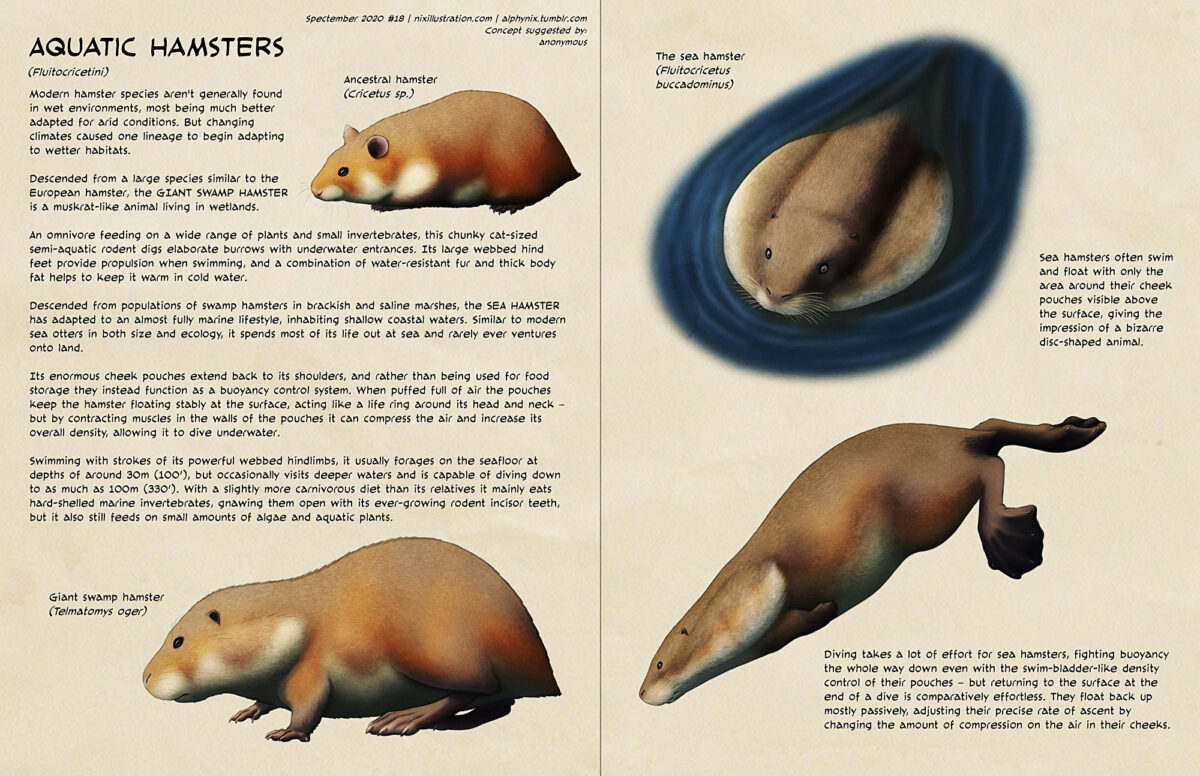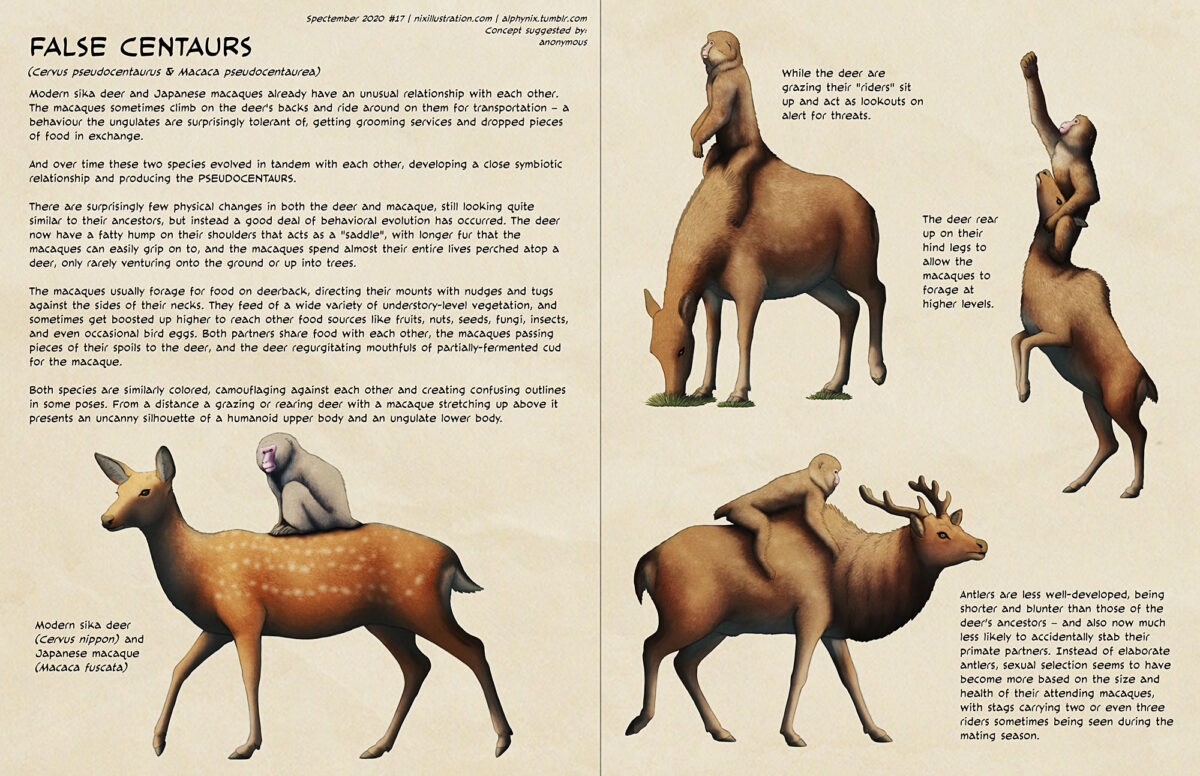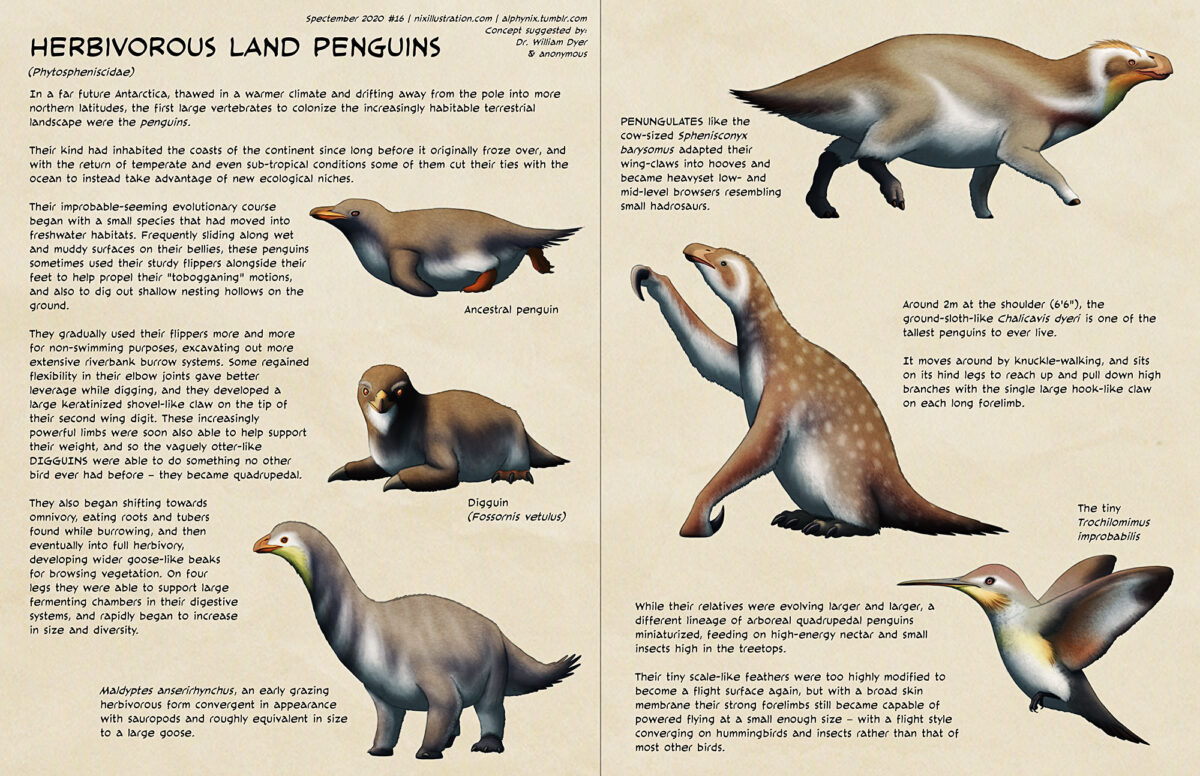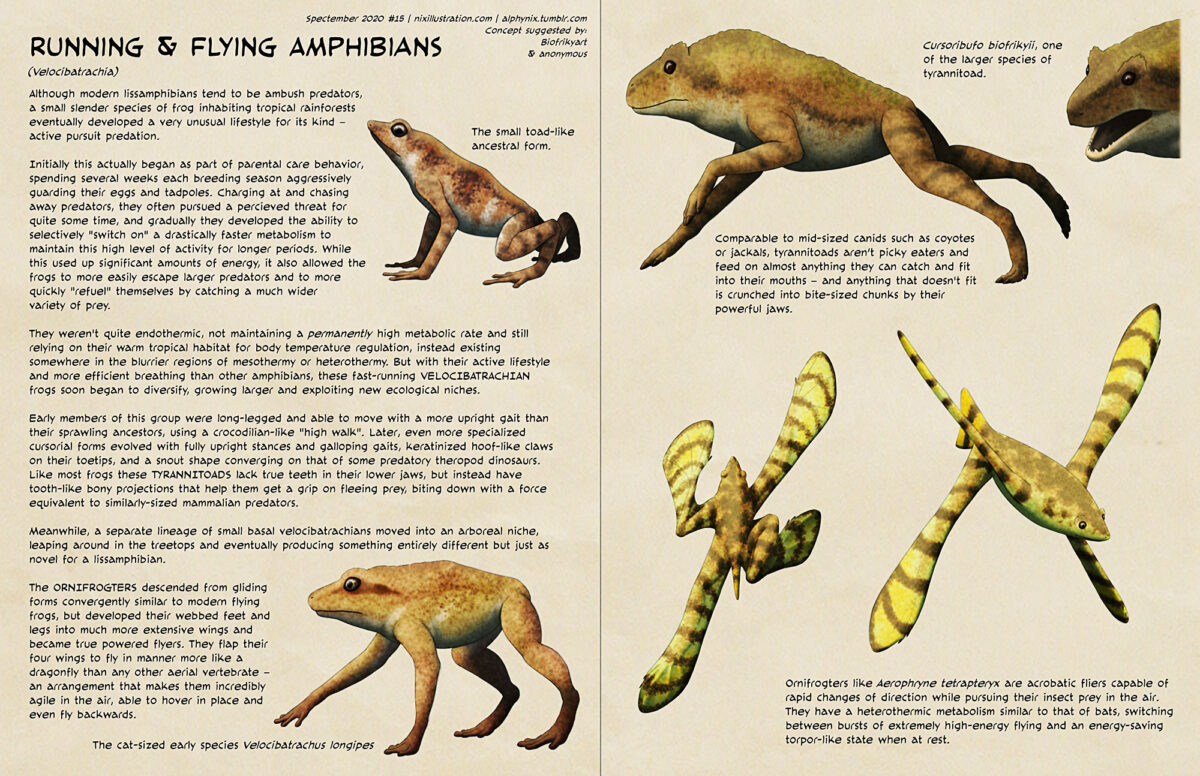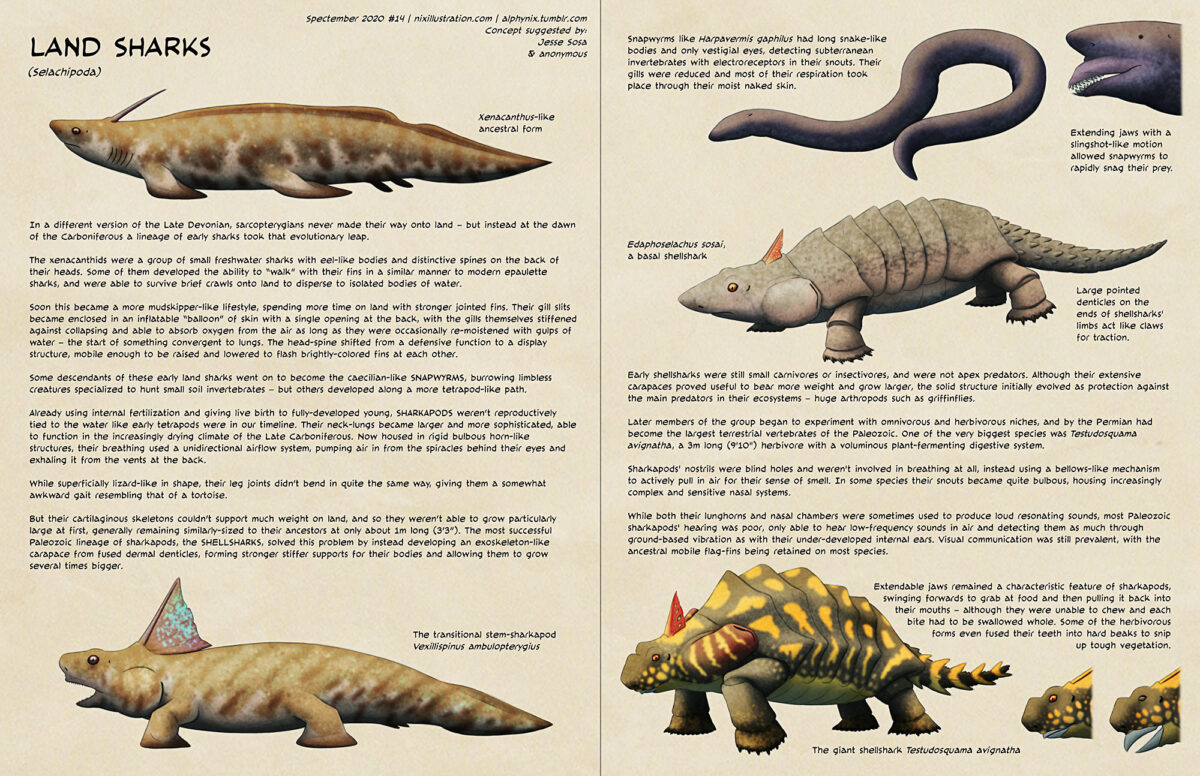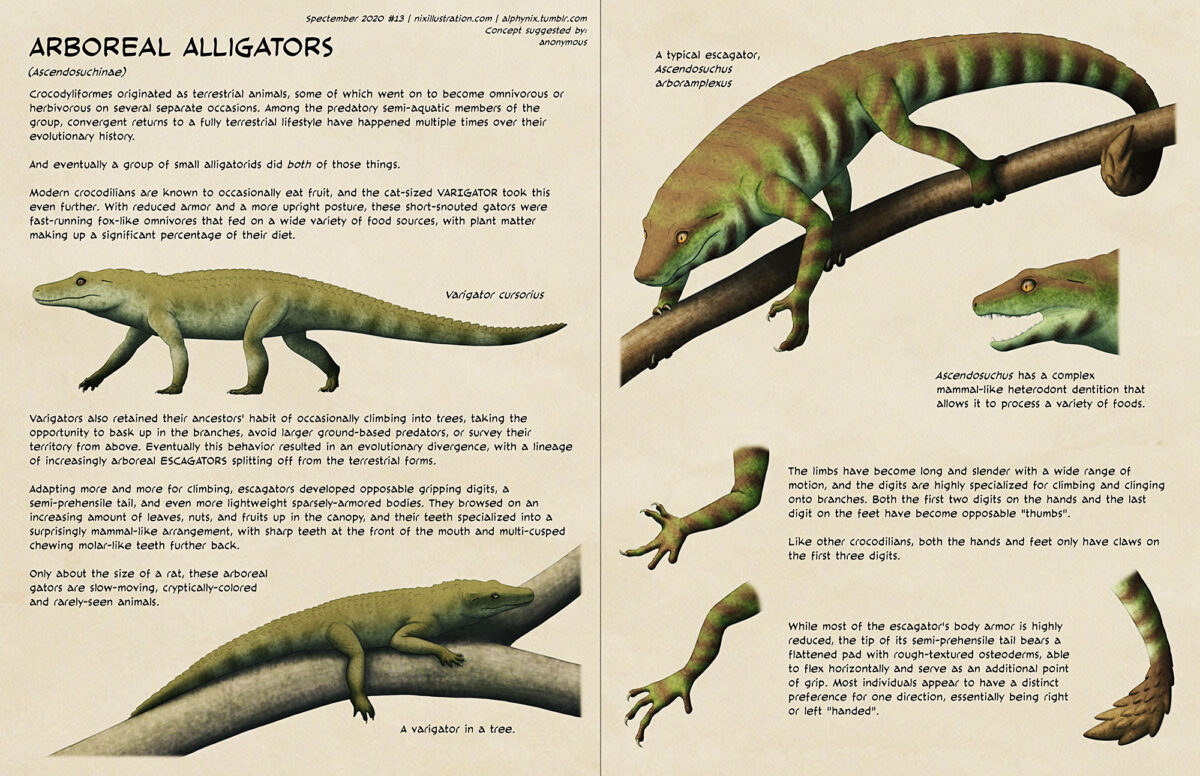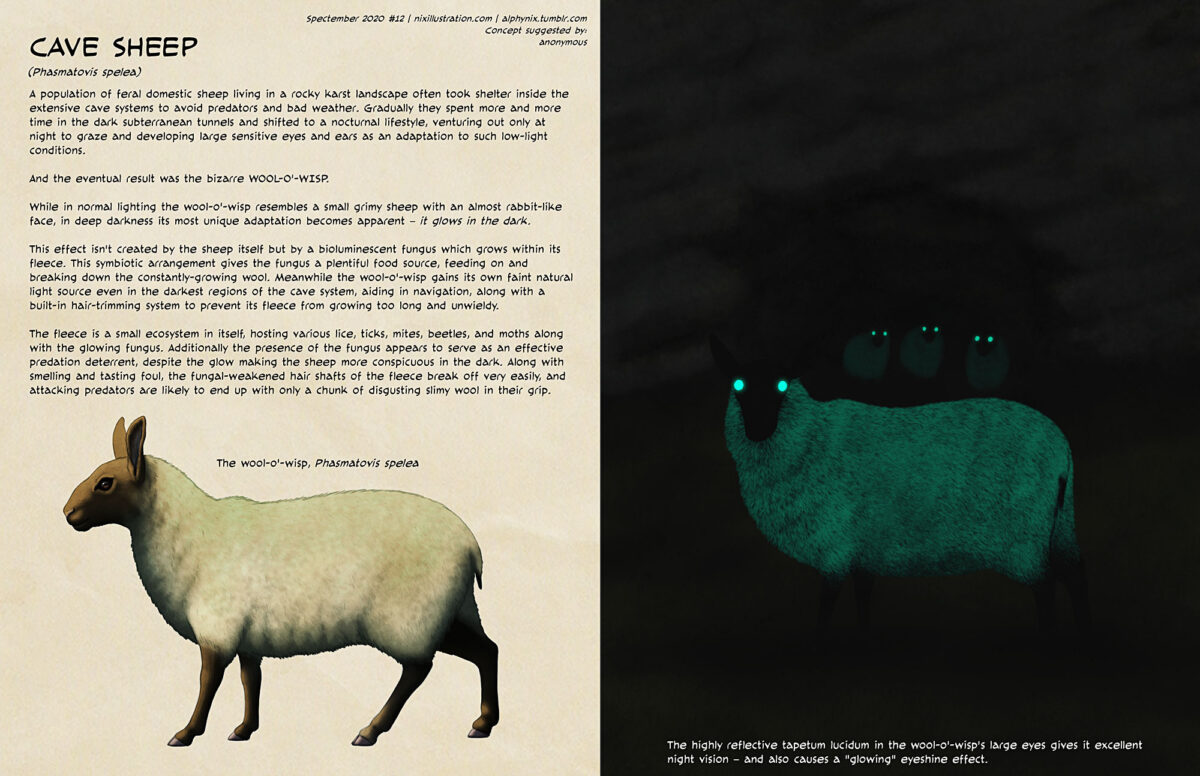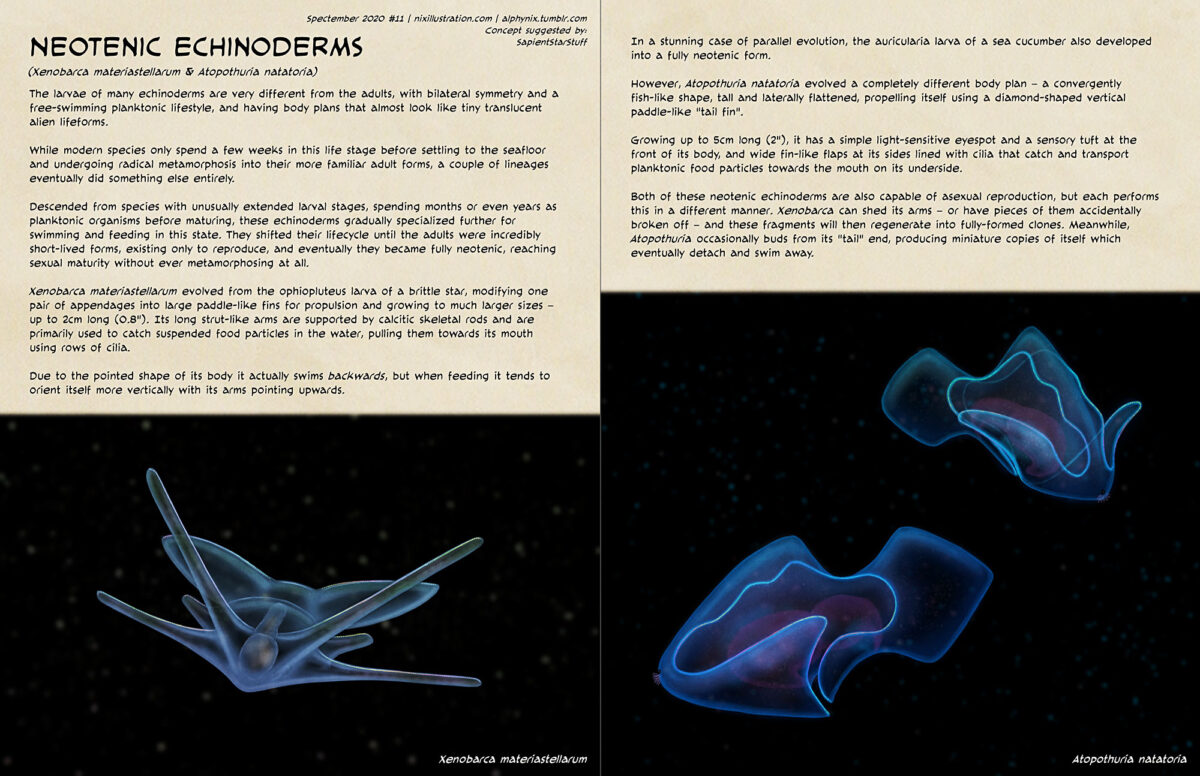Transcript for the text on the image under the cut:
Continue reading “Spectember #18: Aquatic Hamsters”Author: admin
Spectember #17: False Centaurs
Transcript for the text on the image under the cut:
Continue reading “Spectember #17: False Centaurs”Spectember #16: Herbivorous Land Penguins
(also flying ones because why not)
Transcript for the text on the image under the cut:
Continue reading “Spectember #16: Herbivorous Land Penguins”Spectember #15: Running & Flying Amphibians
Transcript for the text on the image under the cut:
Continue reading “Spectember #15: Running & Flying Amphibians”Spectember Interlude: All Yestermorrows
C. M. Kösemen, also known as “Nemo Ramjet” or “Memo”, is a Turkish artist and researcher known for his paleoart, photography, surreal and sometimes Gigeresque imagery, and speculative evolution work.
His 2006 book All Tomorrows explores a speculative future in a similar manner to Last and First Men and Man After Man. While often haunting and strange, and occasionally silly or oddly touching, potential readers of All Tomorrows should be aware of possibly disturbing content, since it does contain some nudity and body horror along with plot elements of eugenics, xenophobia, religious fanaticism, and repeated genocides.
Beginning close to our own present day, the story covers many millions of years of evolution and genetic engineering, all framed as the “best guess” reconstructed history of humanity as assembled by a paleoanthropologist living a billion years from now.
It starts off fairly tame, with minor anatomical divergences in Martian colonists, a war for planetary independence, and the development of a genetically engineered spacefaring subspecies of human – but then things start to get weird. What is initially believed to be a complete lack of other intelligent life in the Milky Way is thrown into question by the discovery of a fossil of an unmistakably Earth-based lifeform on a distant alien world – hinting at the existence of an incredibly ancient and powerful civilization, capable of transplanting and genetically modifying species for unknown purposes.
…A civilization which eventually revisits the human-colonized galaxy, and proves to be intensely hostile. In the aftermath of this devastating first contact, posthuman survivors evolve and rediscover each other, fight more wars, contact other aliens, and even return to the long-lost Earth.
In 2008 Kösemen completed his most well-known speculative evolution project – Snaiad, a huge worldbuilding endeavor that depicts the natural history of an alien planet.
A world much older than the Earth, the planet Snaiad experienced multiple cataclysmic mass extinctions over its eight billion years of evolutionary history, essentially “resetting” complex life a few times. While there are a couple of enigmatic hints in the fossil record of what may have been past civilizations, the fauna at the time of human colonization contains no sapient species.
The main branch of Snaiadi life catalogued in the project are the highly diverse “vertebrates“, which are superficially convergent with Earth tetrapods – but their internal skeletons are hydrocarbon-based, and their four legs are formed from the fusion of eight ancestral limbs. Their primary muscles are hydraulic, evolved from the water vascular system of a sea cucumber-like ancestor, and function based on pushing rather than pulling. What appears to be a “head’ is actually a genital stalk sporting pseudo-jaws often used for food processing, while phallic-looking structures growing from the creatures’ chests contain their true heads and mouths.
An updated version of Snaiad is currently in development, with the goal to eventually publish it in book form.
Kösemen was also a co-author of the 2012 book All Yesterdays, along with Darren Naish and John Conway. Arguing that much of conventional paleoart was outdated, overly conservative, shrink-wrapped, and inaccurate compared to our understanding of animal anatomy and behavior, All Yesterdays mainly explored speculative-but-plausible reconstructions of prehistoric life – and was incredibly influential on modern paleoart, being a major part of the ongoing “second dinosaur renaissance”.
The free “sequel” e-book All Your Yesterdays in 2013 collected together images from many other artists, and featured even more paleontological speculation. Notably one of its entries accurately predicted a later discovery – the speculative filter-feeding “Bearded Ceticaris” by John Meszaros turned out to have had a real-life analogue in the form of Tamisocaris borealis.
2013 also saw the publication of Cryptozoologicon, again a collaboration between Kösemen, Naish, and Conway. Applying speculative biology to various cryptids, this book reviews the evidence for each featured creature and then presents a playful reconstruction of their possible identity and evolutionary history.
Next week: bird is the word.
Spectember Interlude: The Modern Dinosaur Explosion
(Darren Naish over on TetZoo has already done much more extensive coverage on this subject. Check out his series of posts here: part 1 – part 2 – part 3)
The concept of long-extinct prehistoric animals surviving into modern times has been around since at least the mid-1800s, with Jules Verne’s 1864 novel Journey to the Center of the Earth being one of the earliest well-known examples. Many many other pieces of media have since explored the concept, especially with the ever-popular non-avian dinosaurs, but often the depictions were of ancient relict stock species virtually unchanged after millions of years.
Two things in the 1980s began to change this idea, however. Obviously Dixon’s The New Dinosaurs in 1988 was a major influence – but there was also the infamous dinosauroid.
Emerging from some rather exaggerated ideas in the 1970s about the level of intelligence of relatively “big brained” troodontids, the dinosauroid started as a “thought experiment” in a 1982 article by paleontologist Dale Russell and taxidermist Ron Séguin. Unfortunately the resulting creature was heavily anthropomorphized, and while every element of its anatomy was justified as being the “best” evolutionary solution for a big-brained bipedal creature there was obviously a lot of human-centric unconscious bias in its design.
But it was wildly popularized in media at the time, and incarnations of it have regularly appeared in dinosaur-based pop culture ever since. (And it’s also unfortunately become intertwined with antisemitic conspiracy theories, often being used as a visual representation of “lizard people”.) Many other hypothetical sapient dinosaurs have appeared in various works over the years, usually also derived from maniraptoran theropods – although exceptions like Star Trek‘s hadrosaur-descended Voth do also exist.
But getting back to non-sapient dinosaurs… let’s talk about The Speculative Dinosaur Project!
Also known as “Specworld” or just “Spec” for short, this was an absolutely massive collaborative online worldbuilding project in the same vein as The New Dinosaurs – a world where the K-Pg asteroid impact never happened, there was no mass extinction, and non-avian dinosaurs continued to dominate global ecosystems.
Started by a July 2001 thread on the Dinosaur Mailing List, Specworld quickly branched off into its own dedicated website. The main contributors and project runners were Daniel Bensen, David Marjanović, Brian Choo, and Mette Aumala, but there was a huge list of other names involved over the years, and many of them went on to become professional paleontologists, biologists, writers, and illustrators.
(Additional contributors included Tim Morris, Clayton Bell, Brett Booth, João Boto, Steve Brusatte, Stacey Burgess, Martin Chavez, Morgan Churchill, Anthony Docimo, Michael Habib, Michael Hanson, Daniel R. Heald, Jonas Holjer, Emile Marc Moacdieh, David Namen, Eric Christopher Ømtvedt, Donald Ridenbaugh, Edgar Segovia, Ville Sinkkonen, Chris Srnka, and Raymond Tobin.)
Presented as the observations of scientists studying a parallel-reality version of Earth, full of the results of 66 million years of divergent evolution, Specworld developed a huge variety of speculative species and ecosystems.
Both avian and non-avian dinosaurs were abundantly represented (as would be expected in something called The Speculative Dinosaur Project!), with creations such as arboreal ornithopods, spiny theropods, huge grazing sail-backed sauropods, ant-eating noasaurs, and the disgusting “dire rhea” and “rectal probe”. But groups other than dinosaurs were also given a fair amount of attention, including butt-gilled turtles, ankylosaur-like crocodiles, whale-like squid, burrowing sea cucumbers, skunk-like geckos, bone-crushing platypuses, gliding multituberculates, cookiecutter tadpoles, symbiotic spiders, and terrifyingly toxic plants.
At one point there were plans to eventually publish all this as a physical book, but it never came to fruition.
Specworld’s progress began to stall around 2005 or so when Daniel Bensen stepped down from the main editor role, unable to devote enough time to it while in college. Others continued developing Spec for several years afterwards, making revisions to fit in with newer paleontological discoveries that had made some elements of the world outdated, but the original website was abandoned in late 2008 and discussion was moved to a Yahoo Group — which then shut down in 2019 with the closure of that service.
Most of Spec’s content is still around, but currently everything seems to be a bit fragmented. Parts are archived on the Speculative Evolution wiki, along with a Russian site featuring a saved English version, and much of the old site can still also be viewed on the Internet Archive Wayback Machine.
Tomorrow: All Yestermorrows and some more aliens.
Spectember #14: Land Sharks
(I will probably do more with these pipe-necked weirdos at a later date.)
Transcript for the text on the image under the cut:
Continue reading “Spectember #14: Land Sharks”Spectember #13: Arboreal Alligators
Transcript for the text on the image under the cut:
Continue reading “Spectember #13: Arboreal Alligators”Spectember #12: Cave Sheep
Transcript for the text on the image under the cut:
Continue reading “Spectember #12: Cave Sheep”Spectember #11: Neotenic Echinoderms
Transcript for the text on the image under the cut:
Continue reading “Spectember #11: Neotenic Echinoderms”
